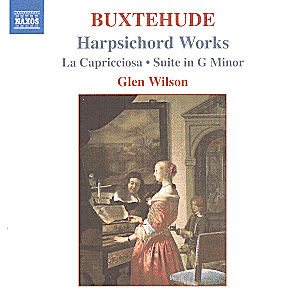It is amazing how the
dead hand of Queen Victoria still rests
heavily on our shoulders. Perhaps the
good Queen was herself not so much to
blame but from wherever it came, our
idea of musicians has until recently
been cast in the Imitatio Christi
mode. Great composers must therefore
of necessity come from humble beginnings,
be surrounded by superficial and unworthy
competitors who achieve greater material
success, and must be misunderstood by
their contemporaries, dying miserably.
If the facts donít fit the legend, then
it is the facts that must fall.
In the case of Bach,
this meant that Buxtehude and Telemann
could not possibly be great composers,
for the one was merely the predecessor,
the vessel; and the other the poncy
showman, the Devilís tool. It was not
difficult to find music by these men
which could be used to support these
absurd ideas. Fortunately the light
is beginning to dawn. My friend Paul
Jordan, a genius at planning as well
as playing great programs of organ music,
when we discovered that his recording
of Bachís Orgelbüchlein
was too long for a single CD, filled
out the second CD 50% with Buxtehude
and the result is not only magnificent
but amazing, for the Buxtehude stands
up solidly under this direct comparison
with some of Bachís greatest music.
Itís largely in how it is played; if
you play great music as
great music it is received that way;
if you play great music as though it
were second rate, thatís how it usually
sounds. So, here we have Buxtehude played
as though it were great music, and thatís
just how it comes off.
Further encouragement
of the Buxtehude restoration included
the publication of the Buxtehude
Werke Verzeichnis by Georg Karstadt
in 1974, and of a good biography in
English, Dietrich Buxtehude, Organist
in Lübeck by Kerala J. Snyder,
1987.
Although I have his
complete organ works, I never knew Buxtehude
even wrote this much harpsichord music.
Not surprisingly, these
sonatas sound about halfway between
Biber and Purcell in style, so if you
like either of these composers you should
like these works right off. All the
movements have Italian tempo indications.
Of the seven, three are in the frequently
encountered slow-fast-slow-fast format,
one is in slow-fast-slow, one in fast-slow-fast-slow,
and two are in fast-slow-fast-slow-fast-slow-fast
format. Like Buxtehudeís organ music
the movements are made up of shorter
episodes of contrasting colour and tempo,
rather like Purcell, instead of the
Baroque ideal of a movement in one tempo
and form throughout. The works also
have much of Purcellís humour and sprightliness
and also Purcellís originality and ability
to surprise and delight. Performances
are excellent, virtuosic, rich and sympathetic,
and the recording is close.
Wilsonís harpsichord
is a beautiful sounding instrument miked
very close but with no distracting mechanical
noises. Temperament is unequal, but
very skilfully applied. BuxWV 250 is
described in the notes as "Buxtehudeís
Goldberg Variations", being an
aria, Bergamasca, and a catalogue
of 32 variation styles, most of them
very French, although much is owed to
Sweelinck. Variation twelve or thereabouts
is remarkably chromatic, simple in its
structure, and exploratory in its harmonies,
while other variations a dazzling virtuoso
displays. Variation 20 or thereabouts
is startlingly similar to Bachís WTK
I Prelude #1. Variation 27 is thought
to satirise unskilled ornamentation
technique and graceless phrasing. Variation
29 could be a hornpipe. BuxWV 179 is
a chorale partita on a German hymn tune,
but consists of French dance movements!
These disks demolish the commonly held
image of Buxtehude as stuffy, crude,
graceless and excessively pious. May
they both be the first of long series
of recordings of secular keyboard and
concerted music.
Beautiful, exciting
music, a revealing testament to a deeply
underestimated composer
[Saying BWV ("Bee-doub-el-you-vee")
is manageable, BuxWV (Books-te-hoo-de-doub-el-you-vee)
is not, so I say "bux-wuv"
or "Bux-wux."]
Paul Shoemaker


![]() John Holloway, v.; Jaap ter Linden, vla. da
gamba; Lars Ulrik Mortensen, harpsichord.
John Holloway, v.; Jaap ter Linden, vla. da
gamba; Lars Ulrik Mortensen, harpsichord.![]() NAXOS 8.557248 [57.32]
NAXOS 8.557248 [57.32]
![]() Glen Wilson (harpsichord by Schevikhoven after
Ruckers 1626)
Glen Wilson (harpsichord by Schevikhoven after
Ruckers 1626) ![]() NAXOS 8.557413 [55.19]
NAXOS 8.557413 [55.19] 





